Why CEOs and Executives Should be on Linkedin

LinkedIn remains the most powerful and important B2B platform for professionals.
In 2021 I wrote about why CEOs and executives should be active on LinkedIn. I’ve updated that post in light of the news about LinkedIn members reaching 1 billion.
**Updated November 17, 2023**
I have been surprised by the number of clients who have asked me this question: “Why should my CEO and senior executives be on LinkedIn?” To me, it seems self-evident: As a professional, LinkedIn is the primary way to make connections and brand yourself online.
But some senior executives still treat their LinkedIn profiles with what could charitably be described as benign neglect.
In this blog post, I will explain:
- What LinkedIn is and why it’s important
- Why the c-suite should take LinkedIn more seriously
- What best practices are for LinkedIn profiles
- Which metrics to track to evaluate your progress
What Is LinkedIn?
LinkedIn is the world’s largest professional network on the internet, with 1 billion users as of late 2024. In short, it’s a social media platform that acts as a professional networking site, designed to help people make business connections, share their experiences and resumes, and find jobs.
LinkedIn is similar to other social media sites like Facebook. It’s built around:
- linking to friends (or, in the case of LinkedIn, “connections”)
- posting updates
- sharing content
- liking and commenting on others’ posts
- direct messaging other users
LinkedIn also just introduced a button that will summarize long posts into a few key bullet points tailored for each user. For example, a sales professional will receive a different summary than a stockbroker.
LinkedIn, while not as ubiquitous as Facebook or Instagram, is nonetheless important in the business community:
- LinkedIn has 1 billion users
- 137 million US members use LinkedIn daily
- 80% of LinkedIn users drive business decisions
- 98% of LinkedIn users have a post-secondary education
Why the C-Suite Should Be Active on LinkedIn
As the only network devoted specifically to businesspeople, LinkedIn is unique among social media channels. Here are the primary reasons executives should be active on the platform:
- People will always be looking for you: Whether they are peers, investors, journalists, job seekers, or potential business partners, LinkedIn is the first place people look to learn about other professionals.
- LinkedIn helps people find you: Due to Google’s search algorithms, often it’s someone’s LinkedIn profile that people see near the top of the results when they look online:
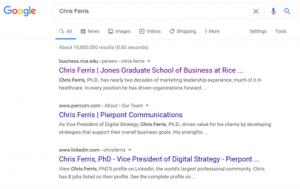
- Your LinkedIn profile tells your story and cements your professional brand: Your LinkedIn profile tells a story about you. And you have 100% control over what your LinkedIn profile says and tells people about you. It’s a remarkable opportunity to tell your own story and brand yourself professionally.
- You set an example: A company’s top executives are usually its most visible individuals to the rest of the world. And internally, their actions set an example for the entire organization to follow.
In short, a polished digital presence that tells your story and is easy to find should be a top priority for all executives.
Executive Profile Best Practices for LinkedIn
- Compelling Background Picture: Background images set the tone for your profile, allowing you to convey a message about your executive brand and the company you work for.
- Profile Picture: Choose a professionally taken photo that is clean and clear of any distracting background noise.
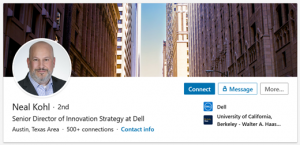
- Headline: Carefully write your profile headline to communicate not just your job title, but your areas of expertise and other positions you may hold.
![]()
- About: Your LinkedIn summary is a condensed version of your executive resume. Select and use keywords to ensure your profiles show up in searches for your areas of expertise. A brief and well-written About section is a must for senior leaders and executives.
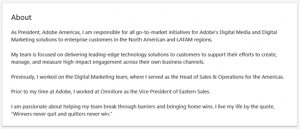
- Providing Services: These are keywords that LinkedIn uses to index your profile and show it to other LinkedIn users when relevant. LinkedIn allows up to 10 services, so take advantage of as many as suit your profile.

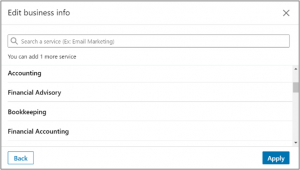
- Activity: Being active on LinkedIn will help your name—and your business’ name—be more visible online. Also, linking, commenting, and sharing helps you expand your online and establish connections with others in your industry.
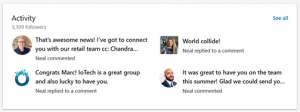
- Featured: This section allows LinkedIn members to highlight select posts and add links to external websites, webinars, news stories, images, or videos. It’s a helpful way to highlight mentions of yourself across the internet.
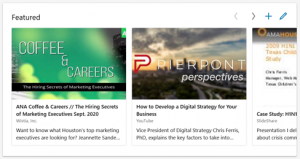
In addition to updating your LinkedIn profile page, it’s also important to engage on LinkedIn. Specifically, this means:
- Interact with other professionals on LinkedIn, including:
- Commenting on their posts
- Sharing their posts
- Reacting to their posts
- Connect with peers or other professionals in your industry
- Accept connection requests – but be judicious about which ones
- Post valuable content from trusted sources, like newspapers, magazines, and trade journals
- Nurture relationships with your network by introducing people to one another and making business connections
- Keep it positive and professional:
- Don’t treat LinkedIn like Facebook: it’s a network built and designed for professional topics
- Think of LinkedIn as a professional networking event
- Don’t criticize others; spend your time finding articles or individuals to praise and highlight
Individually, each of these best practices is important. But taken together, they will add up to a far more robust, complete, and compelling LinkedIn profile.
What To Measure
But how can you tell if your new and improved LinkedIn profile is working? In addition to the number of connections (what LinkedIn calls, “Followers”), here are a few metrics to keep an eye on by accessing your Dashboard:
![]()
- How many profile views do you have over time? This number will not likely continually rise, but a steady stream of profile views means you’re visible on LinkedIn:
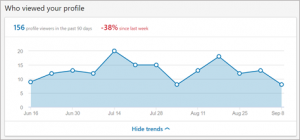
- Search appearances are an indicator of the number of times your profile appeared in search results in the last week. This is largely driven by what people on LinkedIn are searching for, but it’s another number that you’d like to see remain relatively steady, if not grow.

- Where your searchers work lets you know if your profile is showing up in the search results of people who work at businesses that you want to connect with and have been seen by.
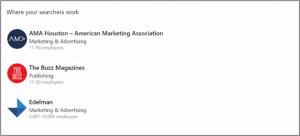
- Keywords your searchers used to identify whether you’re showing for the appropriate search terms. If not, you should consider revising your job title, headline, and about section.
Summary
In sum, think of LinkedIn as a virtual networking event. If you show up to an in-person event in casual clothes, standing in the corner, not wearing a name tag, and not talking to anyone else, you won’t have a successful and productive time.
But if you dress in industry-appropriate clothes, wear a name tag, engage with other attendees, and look up from your phone, you’ll make interesting and potentially meaningful connections. Updating your LinkedIn profile and engaging on the platform with some regularity is the online equivalent of preparing and acting appropriately at a networking event or conference.
Your LinkedIn profile is a virtual—and very visible—representation of you, your professional brand, and your business. So treating your profile with the same care and attention you pay to yourself is worth the time and effort—especially for senior business executives.
LinkedIn Premium, which offers subscriptions ranging from $39 to $120 per month, is primarily used by job seekers, recruiters, and sales professionals. If you do not fall into one of those categories, it is likely not worth the subscription cost.
Contact Us